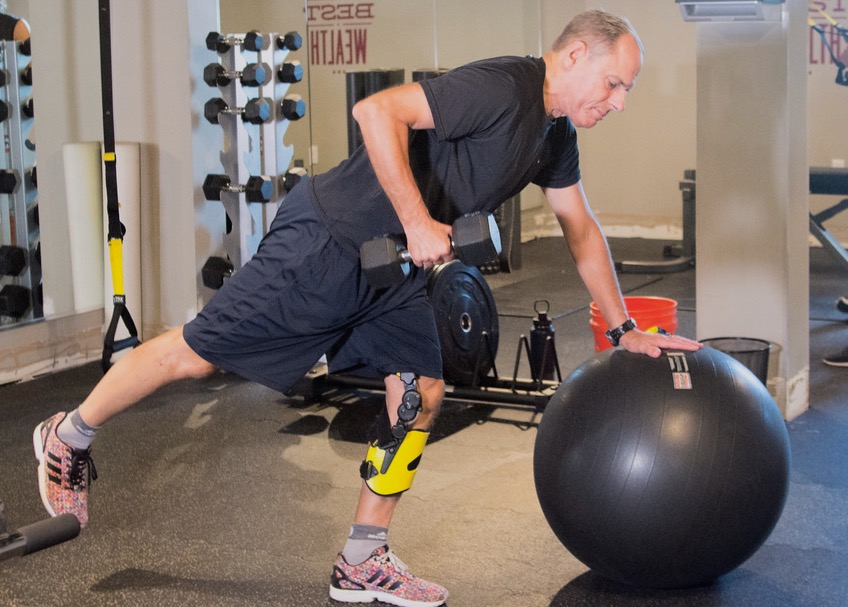Watch any World Cup race and you’ll see athletes employing incredible core strength as they hurtle downhill. Let’s look at exercises to strengthen your core musculature.
Many of you have likely done sit-ups and crunches at some point. Fifteen years ago, I was that guy doing sit-ups on a decline bench while holding a 25- or 35-pound plate. New research has shown that sit-ups stress the lumbar vertebrae at a level near National Institute for Occupational Safety and Health [NIOSH] safety limit.
Shirley Sahrmann notes that crunches train the rectus abdominis and internal obliques, but not the external obliques. Even a twisting crunch — say bicycles or Russian twists — don’t adequately train external obliques.
The movements demonstrated below are based on the concepts of anti-flexion and anti-rotation. While your spine may flex and rotate during sport — think golf, baseball, or a snowboarder doing tricks in the halfpipe — you want to control that flexion and rotation. New thinking in the fitness community is that the purpose of the core muscles — rectus abdominis, obliques, erector spinae — is to prevent the spine from rotating and from flexing. Think anti-flexion, anti-rotation.
Whether I’m working out or writing a client’s program, I prefer to do core strength after training upper and lower body.
Herewith, the moves. Let the games begin!
Plank
Although this movement may be familiar to readers, it’s a foundational position worth reviewing. Get up to your toes and forearms; your shoulders should be stacked over your elbows. Keeping a neutral spine, contract your abdominal muscles and glutes just as hard as you can.
If you’re new to this, try four 15-second holds. You can gradually increase up to one-minute holds. Clasping your hands is cheating, don’t do it. If you “feel it” in your low back, lower your hips, and you’ll get that burn in your abdominals.
Some strength coaches feel that there’s no additional gain holding a plank for more than a minute. If you can maintain plank position for one minute, you’re likely ready to progress to planks with your feet elevated.
Body Saw
A body saw is another way to progress from the plank position. You’ll need Valsides for this. You can find them on performbetter.com or amazon.com, and then have many others uses. Assume the plank position, with your toes on the Valslides, and move your body back and forth with your forearms and shoulders.
If these are too challenging, you can regress the movement by placing your forearms on a stability ball and rolling out, being sure to keep your spine straight. The smaller the stability ball, the more challenging the movement will be.
Rollout
This move utilizes an ab wheel. Like Valslides, they’re available from Perform Better or Amazon. Don’t waste the extra money for those super wide, barrel looking things.
Place your knees on a mat or a stability pad, grab the handles on the ab wheel and roll on out. It’s that simple.
Side Plank
This movement will train your external obliques. Your shoulder should be over your elbow. Shoot for four 15-second holds on each side.
Cable Anti Rotation
A progression from the side plank. The knee closer to the cable column should be up. Keep your shoulders squared and use a short range of motion to avoid twisting your spine.
Any questions, please leave a comment. If you live near one of my studios, you’re welcome to schedule a meeting for a complementary assessment. Just mention that you saw the story on NYSB. Good luck, winter is just around the corner!
As always, my expectation is that readers are in good physical shape. If you’ve been inactive, discuss increasing your activity with your physician. If you have orthopedic challenges, like an ACL tear or a joint replacement, or chronic disease issues like hypertension, please consult your physician before hitting the gym.
If you’ve never been in the gym, or if you’ve been away from it for a while, start conservatively. You’re better off doing any move with lighter weight and correct technique. Trying to be a hero is a surefire way to get hurt. If you’re unclear on the instructions or the video, find a trainer in your gym that can cue you on technique.
Peter Minde is a personal trainer certified by the National Academy of Sports Medicine (NASM). He also has NASM’s Corrective Exercise certification and is a Certified Functional Strength Coach. He trains at fitness studios in Morris Plains, NJ; Fairfield, NJ; and in-home. Contact: pete.minde@gmail.com


Crunches out- planks in. You really gave me something to think about here, Peter.
Thanks for posting
This is really helpful as we need to get our butts in shape for ski season. We have been working out probably wrong for a long time then.
Amazing post. Thank you!
So are crunches okay, but not sit ups?
@ TheGreatAbyss, I would avoid crunches. Sahrmann, doyenne of physical therapists, has patients who are really deconditioned doing crunches, or as she calls them, curlups.
The rectus abdominis pulls the pelvis upward (and glutes pull it down). With crunches you’re training abs the opposite of how they were designed to work.
I would avoid crunches altogether.